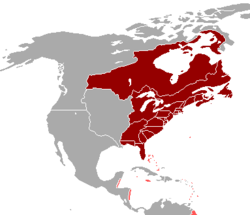
Back أمريكا البريطانية Arabic Britaniya Amerikası Azerbaijani Британска Америка Bulgarian Amèrica britànica Catalan Britská Amerika Czech British America German América británica Spanish آمریکای بریتانیا Persian Brittiläinen Amerikka Finnish Amérique britannique French
British America[a] | |||||||||||||||||||||
|---|---|---|---|---|---|---|---|---|---|---|---|---|---|---|---|---|---|---|---|---|---|
| 1585–1783 | |||||||||||||||||||||
 British colonies in continental North America (red) and the island colonies of the British West Indies of the Caribbean Sea (pink), after the French and Indian War (1754–1763) and before the American Revolutionary War (1775–1783) | |||||||||||||||||||||
| Status | Colonies of England (1585–1707) Colonies of Scotland (1629–1632) Colonies of Great Britain (1707–1783) | ||||||||||||||||||||
| Religion | |||||||||||||||||||||
| Government | Monarchy with various colonial arrangements | ||||||||||||||||||||
| Monarch | |||||||||||||||||||||
• 1607–1625 (first) | James VI and I | ||||||||||||||||||||
• 1760–1783 (last) | George III | ||||||||||||||||||||
| History | |||||||||||||||||||||
| 1585 | |||||||||||||||||||||
| 1610 | |||||||||||||||||||||
• Bermuda | 1614 | ||||||||||||||||||||
| 1620 | |||||||||||||||||||||
| 1632 | |||||||||||||||||||||
| 1655 | |||||||||||||||||||||
| 1667 | |||||||||||||||||||||
| 1670 | |||||||||||||||||||||
| 1713 | |||||||||||||||||||||
| 1763 | |||||||||||||||||||||
| 1775–1783 | |||||||||||||||||||||
| 1783 | |||||||||||||||||||||
| Currency | Pound sterling, Spanish dollar, bills of credit, commodity money, and many local currencies | ||||||||||||||||||||
| |||||||||||||||||||||
British America collectively refers to various European colonies in the Americas prior to the conclusion of the American Revolutionary War in 1783. The British monarchy of the Kingdom of England and Kingdom of Scotland—later named the Kingdom of Great Britain, of the British Isles and Western Europe—governed many colonies in the Americas beginning in 1585.
From 1607, numerous permanent English settlements were made, ultimately reaching from Hudson Bay, to the Mississippi River and the Caribbean Sea. Much of these territories were occupied by indigenous peoples, whose populations declined to epidemics, wars, and massacres. In the Atlantic slave trade, England and other European empires shipped Africans to the Americas for labor in their colonies. Slavery became essential to colonial production, such as in sugar production on the islands of Barbados and Jamaica, both of which were taken from New Spain by England. In 1664, England took the New Netherland colony from the Dutch Republic.
In the 1680s, Britain and France began frequent wars over colonies and trade, including the overlapping territorial claims of British America and New France, and relations with the Iroquois. In Queen Anne's War (1702–1713), the British took Newfoundland and the Hudson Bay area from the French. In the French and Indian War (1754–1763)—the North American theatre of the Seven Years' War—the British won the eastern half of modern-day Canada and the eastern Mississippi valley from New France, and the Floridas from New Spain.
In the American Revolutionary War (1775–1783), thirteen British colonies rebelled against the Crown and formed the United States of America (U.S.), an independent country of thirteen states. In the 1783 Treaty of Paris, which ended the war, Britain recognized the U.S. as an independent country, and ceded to them the British territories directly east of the Mississippi River. The continental territories in North America which the British retained are collectively referred to as "British North America", but the term was only used after the 1839 Durham Report was published.
Cite error: There are <ref group=lower-alpha> tags or {{efn}} templates on this page, but the references will not show without a {{reflist|group=lower-alpha}} template or {{notelist}} template (see the help page).